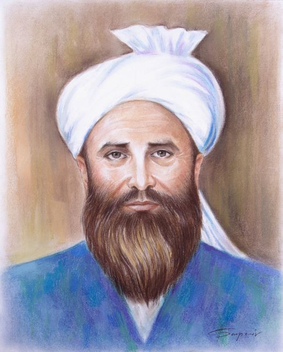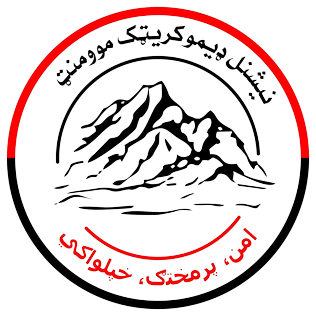
Khyber Pakhtunkhwa, formerly known as North West Frontier Province (NWFP), is a province of Pakistan. Located in the northwestern region of the country, Khyber Pakhtunkhwa is the fourth largest province of Pakistan by land area and the third-largest province by population. It is bordered by the Pakistani provinces of Balochistan to the south, Punjab to the south-east, the territory of Gilgit-Baltistan to the north and north-east, Islamabad Capital Territory to the east and Azad Kashmir to the north-east. It shares an international border with Afghanistan to the west. Khyber Pakhtunkhwa has a varied landscape ranging from rugged mountain ranges, valleys, plains surrounded by hills, undulating submontane areas and dense agricultural farms.

Mohammad Daoud Khan, also romanized as Daud Khan or Dawood Khan, was an Afghan politician who served as prime minister of Afghanistan from 1953 to 1963 and, as leader of the 1973 Afghan coup d'état which overthrew the monarchy, served as the first president of Afghanistan from 1973 until his assassination in the Saur Revolution.

Pashtunistan is a region located on the Iranian Plateau, inhabited by the indigenous Pashtun people of southern Afghanistan and northwestern Pakistan, wherein Pashtun culture, the Pashto language, and Pashtun identity have been based. Alternative names historically used for the region include Pashtūnkhwā (پښتونخوا), Pakhtūnistān, Pathānistān, or simply the Pashtun Belt.

Abdul Ghaffār Khān, also known as Bacha Khan or Badshah Khan was a Pashtun independence activist, and founder of the Khudai Khidmatgar resistance movement against British colonial rule in India.

The national flag of the Islamic Emirate of Afghanistan, adopted on 15 August 2021 following the Taliban's victory in the 2001–2021 war, features a white field with a black Shahada inscribed. Since the 20th century, Afghanistan has changed its national flag several times. The national flag had black, red and green colors most of the time during the period.
Waziristan is a mountainous region covering the North Waziristan and South Waziristan districts of the Pakistani province of Khyber Pakhtunkhwa. Waziristan covers around 11,585 square kilometres (4,500 sq mi) and is mainly populated by the Wazir Pashtun tribe, who speak the Waziri dialect of the Pashto language.

Khudai Khidmatgar was a predominantly Pashtun nonviolent resistance movement known for its activism against the British Raj in colonial India; it was based in the country's North-West Frontier Province.

Bāyazīd Khān Ansārī, commonly known as Pīr Rōshān or Pīr Rōkhān, was an Ormur warrior, Sufi poet and revolutionary leader. He wrote mostly in Pashto, but also in Persian, Hindustani and Arabic. His mother tongue was Ormuri. He is known for founding the Roshani movement, which gained many followers in the Pashtunistan region, in present-day Pakistan and Afghanistan, and produced numerous Pashto poets and writers.
Haji Mirzali Khan Wazir, commonly known as the Faqir of Ipi, was a tribal chief and adversary to the British Raj from North Waziristan in what is now Khyber Pakhtunkhwa, Pakistan.
Pashtun culture is based on Pashtunwali, as well as speaking of the Pashto language and wearing Pashtun dress.
Pashtun diaspora comprises all ethnic Pashtuns. There are millions of Pashtuns who are living outside of their traditional homeland of Pashtunistan, a historic region that is today situated over parts of Afghanistan and Pakistan. While the (erstwhile) Pashtunistan is home to the majority of Pashtun people, there are significant local Pashtun diaspora communities scattered across the neighbouring Pakistani provinces of Sindh and Punjab, particularly in their respective provincial capital cities of Karachi and Lahore. Additionally, people with Pashtun ancestry are also found across India; particularly in Rohilkhand, a region in the Indian state of Uttar Pradesh; and in the Indian states of Gujarat and Rajasthan. Outside of South Asia, significant Pashtun diaspora communities are found in the Arab states of the Persian Gulf, the United States, the United Kingdom, Germany, Iran, Australia, Canada, and Russia.

Razmak is one of the three subdivisions of North Waziristan District in Pakistan, the other two being Mir Ali and Miran Shah. The inhabitants are almost exclusively Wazir Pashtuns, along with a few from the Mahsud tribe. The town of Razmak is located just north of Makeen, South Waziristan.

The History of Khyber Pakhtunkhwa refers to the history of the modern-day Pakistani province of Khyber Pakhtunkhwa.
The Waziristan campaign 1936–1939 comprised a number of operations conducted in Waziristan by the British Indian Army against the fiercely independent tribesmen that inhabited this region. These operations were conducted in 1936–1939, when operations were undertaken against followers of the Pashtun nationalist Mirzali Khan, also known by the British as the "Faqir of Ipi", a religious and political agitator who was spreading anti-British sentiment in the region and undermining the prestige of the Indian government in Waziristan at the time.

Pashtun nationalism is an ideology that claims that the Pashtuns form a distinct nation and that they should always be united to preserve their culture and homeland. In Afghanistan, those who advocate Pashtun nationalism favour the idea of a "Greater Afghanistan", which includes Khyber Pakhtunkhwa, and be ruled directly under Pashtun principles.

The Bannuzai or Banusi, Banuchi, Banisi originally Shitak Afghans. are a prominant Pashtun tribe which has the reputation of being one of the most warlike amongst the Afghan or Pashtun people. They inhabit Bannu,North Waziristan,Dera Ismail Khan and Kurram valley of the Khyber Pakhtunkhwa province of Pakistan, with some members settled in Khost,Paktika,Paktia and Injil of Herat Afghanistan. Shitak was the name of their ancestor. Therefore, according to Afghan/Pashtun traditions, his descendants were called Shitak or Shitakzai, Zai means "son" in Pashto. However, it is more famous by its nicknames like Banuchi or Banusi and these people call themselves Banisi. These titles belonged to this tribe in relation to this region.The words Bannuzai, Banuchi, Banusi and Banisi is strickly used for these people because as they conquered Bannu they interchanged the word Bannu for their tribe i.e Shitak from there they were more famously known as Bannuzais, Banuchi etc.

The National Democratic Movement is a Pashtun nationalist, regionalist, and social-democratic political party in Pakistan. The NDM seeks to resist the "growing militarisation" and promotes a federal parliamentary system. It also aims to provide a platform to women and youth for organising their political activism. It was founded by Mohsin Dawar on 1 September 2021 in Peshawar.
The inaugural meeting of the Pashtun National Jirga, also known as the Bannu Jirga, was held at Mirakhel Cricket Ground in Bannu, Khyber Pakhtunkhwa from 11 to 14 March 2022 to discuss the critical issues faced by the Pashtuns in Pakistan and Afghanistan. It was attended by about 5,000 delegates, including politicians, tribal chiefs, researchers, clerics, religious minorities, women and human rights activists.
Waziristan rebellion was a rebellion by the Pashtun leader Faqir of Ipi to secede from Pakistan and establish a separate Pashtun state of Pashtunistan.



















